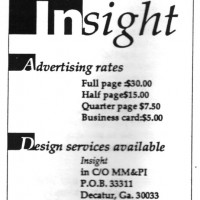What is a Transsexual? (1990)

©1990, 2013 by Dallas Denny
Source: Denny, Dallas. (1990, Winter). What is a transsexual? Insight, the Newsletter of the Montgomery Medical and Psychological Institute, p. 10.
This article was published, in slightly watered-down form, on page 10 of Insight, Winter, 1990. I wrote it in response to a letter of complaint from Catlin Kiernan, a member of the support group of the Montgomery Institute support group in Atlanta.
What Is A Transsexual?
By Dallas Denny
In the last issue of Insight, Cait accused me of having packed the ranks of the MM&PI support group with a “motley collection of ‘gender conflicted’ individuals”– meaning, I suppose, that I let people whom she considers to be crossdressers into the group.
The fact is, if everyone who has been accused by another group member of not being transsexual were to be excluded, the meetings would be very lonely indeed.
Cait makes no secret of her opinion of crossdressers: “If I had wanted to hang around with cross-dressers, comparing shades of nail polish and flashing uninvited glimpses of my underwear to the general assembly, I’d have joined Tri-Ess, what with dear old Sigma Epsilon right there in my own backyard.” She claims to be the mouthpiece for a group of eight or nine people who felt MM&PI, under my guidance, was straying from its goal of serving transsexual people.
Many of the present and former group members came to MM&PI by way of Tri-Ess. There are a surprising number of transsexual people in that organization, as there are people in MM&PI who would be perhaps better served by Tri-Ess. I don’t think former membership in Tri-Ess or designation by Cait as a crossdresser can realistically be considered criteria for exclusion from the MM&PI support group. There must be freedom of movement between the two groups, so Tri-Ess can serve their people and we can serve ours.
Disregarding the fact that Cait is deluded in her belief that a considerable number of others share her venom toward Tri-Ess, and regardless of the fact that she chose to go behind my back with THE LETTER rather than confront me in person, the question remains: what is a transsexual? Who belongs in the group, and who doesn’t? Do we serve those who are seriously unhappy in their assigned gender roles, or do we lay down exclusionary criteria which would eliminate most of the members who are currently in the support group? And if so, whose criteria do we use? Cait’s?
I have read widely of the literature of gender dysphoria, and have found definitions of transsexualism vary. By many of those definitions, Cait herself would be excluded, classified as a crossdresser. So would I. And so, perhaps, would you, gentle reader.
Do we, like Robert Stoller, accept only those who are beautiful in the gender of choice? Do we, like many gender clinics, exclude those who are have had heterosexual relationships or who have been (or, like Cait, still are) married? Do we cast out those who have trouble passing? Those who are over six feet tall? Those who are not suicidal? Those who are? Those who even once have experienced sexual arousal from wearing the clothing of the opposite sex? Those who do not crossdress at meetings? Those who have additional mental or physical problems? Those who have made a homosexual adjustment? Those who are too beautiful (for must they not, then, be drag queens)? Those who are not beautiful enough? Those who do not have enough money to realistically pursue the change? Those whose friends and families are unaccepting? Those who live too far away? Those who have not come to grips with and made the change before the age of 30? Those who, like Cait, go public with their self-diagnosed transsexualism?
I think not. I think that MM&PI must maintain a relatively open definition of transsexualism. We must accept and tolerate individual differences and styles. The group must be a place for those who are seriously gender conflicted, no matter what labels Cait and her cronies would place upon them. That is what the group has been in the past (yes, even before I became director), and that is what it must continue to be. To this end, I think we must use a relatively nonexclusionary definition of transsexualism.
In screening people for the group, I used the most widely accepted diagnostic criteria: the one in the Diagnostic and Statistical Manual of the American Psychiatric Association (DSM III-R), to wit: “A. Persistent discomfort and sense of inappropriateness about one’s assigned sex; B. Persistent preoccupation for at least two years with getting rid of one’s primary and secondary sex characteristics and acquiring the sex characteristics of the other sex; and C. The person has reached puberty.” These criteria are endorsed by the Harry Benjamin International Gender Dysphoria Association, Inc., which notes, in their Standards of Care, “This definition of transsexualism is herein interpreted not to exclude persons who meet the above criteria but who otherwise may, on the basis of their past behavior histories, be conceptualized and classified as transvestites and/or effeminate male homosexuals or masculine female homosexuals.”
Perhaps Cait, self-appointed diagnostician that she is, has a better definition. If so, perhaps she will share it with us. So far, all she has done is whine and gripe and make tempests in teapots.
